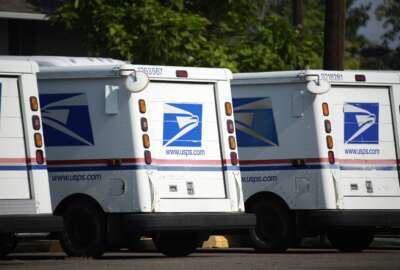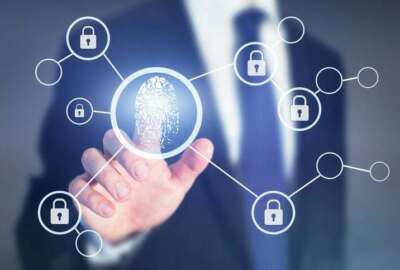

Kiosks are like robots that don't move. They replace people for high-volume, repetitive tasks like checking people in or issuing paperwork. Now the General Serv...
Best listening experience is on Chrome, Firefox or Safari. Subscribe to Federal Drive’s daily audio interviews on Apple Podcasts or PodcastOne.
Kiosks are like robots that don’t move. They replace people for high-volume, repetitive tasks like checking people in or issuing paperwork. Now the General Services Administration is looking for ideas for using kiosks to identify people or issue credentials, remotely. For more details, the Federal Drive with Tom Temin spoke to Darlene Gore, GSA’s director of identity, credential and access management.
Interview transcript:
Darlene Gore: We’re looking for kiosk capability and functionality. The USSS program has been around for 14 years. We issue PIV cards to federal government, about 120 federal agencies. And so the pandemic introduced, you know, new challenges for card issuance, especially because it’s face to face. Most of the functionality is face to face. And so we’re exploring opportunities with kiosks and hopefully we can deliver that PIV card services through kiosks services.
Tom Temin: Right, so that people don’t have to be in person to get a credential. But somehow you have to verify that who they are, is who they say they are.
Darlene Gore: Exactly, exactly. And that is a really important role for PIV card issuers is to verify the identity of the individual that you’re issuing that PIV card to.
Tom Temin: And what’s your general notion of how that can be done without people turning up in person, they might have their birth certificate, or I’ve never got a PIV card. But you know, for a passport or whatever the case might be, there is an original tying of you to that identity, and then you’re good to go from there on.
Darlene Gore: So it doesn’t negate that it will be a person inside of the kiosk, you still are required to do that validation. FIPS allow us to do remote identity proofing. So what the kiosk is, would normally how we’ve seen different vendors that come in and demonstrate their services, they really have like an individual there behind the scenes that is validating those documentation, you will still perform some of the same function, it just won’t be in-person, that person will be looking through the tube. But one of the main things that the kiosks is the challenge of the kiosk is when you go and you visit that kiosk, you can’t move, you can’t dodge, you really have to be spot on for that verification and validation to happen and for it to validate your identity. So it’s similar like not your standard kiosk is like you may go to a kiosk in the airport, and they’re just take a picture of you and it’s a standalone and there won’t be any interactions with a human interaction, the kisok is for PIV service, they’ll be some human interaction, except for what that person would be at a call center. At least that’s what we’ve been demonstrating. And we think that will be successful for PIV card and identity verification.
Tom Temin: And so therefore, you’re looking for the ability of a kiosk to take in biometric information and tell us more about what you might mean specifically?
Darlene Gore: Yes, so the kiosk of, let me just give you a quick rundown on the PIV card enrollment. You have to take your picture, validate your driver’s license, you need two forms of identification, according to FIPS. And also an I-99. That could be your passport and your driver’s license. So what we’re looking for that individual is to take that picture, the kiosk, the kiosk just like you would normally. Take the picture, take the picture of the individual, take the fingerprints of the individual, as well as scan those documents. They can it’s almost like a self service where the individual will put their documents in and they’re scanned. And you see that a lot in the industry today outside of the federal space. You can scan your documents at the airport, you can scan your passport, or you go to Customs, you can scan those documents and they will validate who you are. The same practice for PIV services, you would take your picture there, collect your fingerprints, and all the pertinent documents that are required to validate your identity and verify you are who you are.
Tom Temin: We are speaking with Darlene Gore, she’s director of identity credential and access management in the Office of the IT Category at the GSA. And will you be looking for the software stream and chain needed to accomplish this? Or are you also looking at different kiosk hardware form factors? Or both?
Darlene Gore: We’re looking at both. You know, the great thing about having industry days is that you’re exploring, you want to understand and review different emerging technologies that are out there. So you know, we’re not just tied to one thing, but we’re looking at software capabilities that are compliant with our standards without NIST standards and our FIPS standards and also hardware capability that are secure that could plug into the backend connecting to the backend of our system for this services. So we’re looking for both.
Tom Temin: And under the system, this classic system for issuing PIV cards, does this take place at the individual agency level or do people now under ordinary times go to a central location, regardless of the agency?
Darlene Gore: So currently the business today currently is that you will go to a federal site. However, during the pandemic, we explored a pilot with the U.S. Postal Service. I’m sure you’ve heard about that.
Tom Temin: Sure.
Darlene Gore: And what that allowed us to do for the first time was to deliver federal services through the Postal Service. So what we’re really, what we’re looking at is how do we expand this footprint and our roadmap because the total workforce is changing, as you’re probably familiar with OMB’s directive on a total workforce to be able to work from any location now. So now the federal government has to catch up with that. They may not be coming to a federal business, a business to do those functions, we have to explore the opportunity, expanding that service outside the federal government. So that may mean that we could have a kiosk and a location in a secure location, so that federal employee can continue those federal functions without having to come to a federal building.
Tom Temin: Right. So if someone was, say, approved for a job at GSA, and you needed to get that PIV card, they could go to a post office or maybe some other type of location. And could that particular kiosk be multiple function like push here if you’re getting a refund at the store, push here if you’re signing up for a PIV card at the GSA?
Darlene Gore: Well, it would not have, it’d have multiple federal functions. It could potentially have multiple federal functions. And what I mean by that, because one of the main as we mentioned before was the collection of the biometrics. So for example, if you have a suitability and you have to, and you’re onboarding an employee, you have to collect those biometrics. So as multipurpose agency can choose to send that individual and this is notional how our vision is that agencies can choose to send that individuals to that kiosk to collect those biometrics that will serve multiple purposes. One could be for suitability, that person is onboarding employee and the other continuing on to PIV card issuance. But it’ll have one collection point that that individual can go to, instead of going to, I got to go to my federal agency to collect for my background investigation, you can just go to, it’ll be a one stop shop, basically.
Tom Temin: Right. And so you envision, again, notionally these kiosks being in postal offices, and I suppose there are other maybe large types of publicly available federal locations, besides post offices maybe?
Darlene Gore: Yeah, possibly get on PBS (Public Buildings Service), GSA is in charge of PBS. And we can probably explore some PBS buildings that we can distribute these kiosks at any federal entity. We’re not just, in some of the federal agencies also may opt in to have a kiosk service where they can just go in and not have a clerk there because we have about nearly 3,000 sites nationwide that the federal agencies right now man, with clerks with registrars so they could maybe opt in, we can still use that same footprint, but also complement it with footprint outside of the federal government that will expand the footprint across the U.S.
Tom Temin: And I guess kiosk technology itself has changed a lot. So maybe they don’t have to be big giant plastic or metal size of a mailbox, you know, or something that can be maybe a desktop type thing that could be in a carrel, stand up cubicle type of thing, almost like a voting booth.
Darlene Gore: Yep, it could. It’s funny, you should say that because I’ve seen them all. And one of the reasons why this is so important to the federal government because I’m a traveler. I don’t know about you, Tom. But I’ve seen the change in Customs and how you can go through Customs. And they are now they have these little kiosks on a pedestal it just a little small, little slim, not very large at all. So I envision that the government can follow the same procedures and streamline the equipment footprint at least because we always have clunky equipment services when we deliver our services. So we need to streamline that a little bit. So I could be just a little pedestal, a little small petite pedestal, or it could be a big clunky one.
Tom Temin: Right.
Darlene Gore: That’s what we’re hoping to explore at the industry day.
Copyright © 2024 Federal News Network. All rights reserved. This website is not intended for users located within the European Economic Area.
Tom Temin is host of the Federal Drive and has been providing insight on federal technology and management issues for more than 30 years.
Follow @tteminWFED


